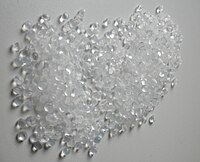
Photo from wikipedia
Hydrophobic surfaces are highly desired for several applications due to their exceptional properties such as self-cleaning, anti-icing, anti-friction and others. Such surfaces can be prepared via numerous methods including plasma… Click to show full abstract
Hydrophobic surfaces are highly desired for several applications due to their exceptional properties such as self-cleaning, anti-icing, anti-friction and others. Such surfaces can be prepared via numerous methods including plasma technology, a dry technique with low environmental impact. In this paper, the effect of a one-step sulfur hexafluoride (SF6) plasma treatment upon the low velocity impact behavior of basalt/epoxy composites has been investigated by using several characterization techniques. A capacitive coupled radiofrequency plasma system was used for the plasma surface treatment of basalt/epoxy composites, and suitable surface treatment conditions were experimentally investigated with respect to gas flow rate, chamber pressure, power intensity, and surface treatment time by measuring the water droplet contact angle of treated specimens. The contact angle measurements showed that treating with SF6 plasma would increase the hydrophobicity of basalt/epoxy composites; moreover, the impact results obtained on reinforced epoxy basalt fiber showed damage in a confined area and higher impact resistance for plasma-treated basalt systems.
Journal Title: Polymers
Year Published: 2021
Link to full text (if available)
Share on Social Media: Sign Up to like & get
recommendations!